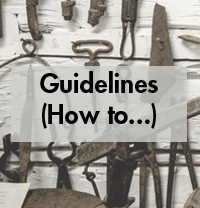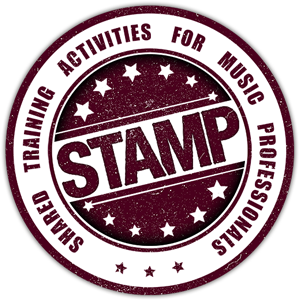In this chapter we have gathered some guidelines with practical tips,
partly provided by different project partners
– How to make your events eco-friendly (EMC)
German version / Deutsche Übersetzung
– NEW: Environmental Protection and Climate change:
iiiFood for thought for associations, choirs and singers (ECA-EC)
German version / Deutsche Übersetzung
– How to make a Webinar (CCRSM)
German Version / Deutsche Übersetzung
– How to ensure safety at your events (Estonian Academy of Music and Theatre)
– How to write concert programme notes (ECMTA)
And of course the Guidelines on How to Organize a YEMP, developed as part of the STAMP project.
The Youth Committee of the European Choral Association some years ago put together some simple guidelines for young people working internationally:
– Visitng an event as participant
– Visiting an event as representative of your association
– Being a volunteer at an event
– Being the mentor of the youth committee
– Tips for new members of the youth committee
And the Youth Committee of the European Choral Association – Europa Cantat gathered some further “How to ….” tipps below.
How to make a good (powerpoint) presentation
- Keep it Simple
- Limit bullet points & t (not too much, remember people have to read it)
- Limit transitions & builds (animation)
- Use high-quality graphics (pictures can say more than words)
- Have a visual theme, but avoid using PowerPoint templates. …
- People love charts – Use appropriate charts, e.g. pie charts to illustrated
- Use color well. …
- Choose your fonts well (and use a font that is “universal” if you are not using your own PC)
9. Insert video or audio files (inserting means they will automatically play, no need to jump between programmes)
10. Use the slide sorter
11. Don’t put full sentences into the PPT and don’t read out exactly what is in your presentation
Inspired by http://www.garrreynolds.com/preso-tips/design/
Some useful links how to make a good powerpoint presentations with free tools to download:
- https://www.slideshare.net/damonnofar/8-tips-for-slideshare
- https://blog.hubspot.com/marketing/easy-powerpoint-design-tricks-ht
- https://business.tutsplus.com/tutorials/powerpoint-presentation-tips–cms-29886
How to write good minutes:
To write effective meeting minutes you should include:
- The names of the participants.
- Agenda items.
- The main points.
- Decisions taken (mark decisions clearly)
- Calendar or due dates.
- Actions or tasks and who will do what (To Do Lists)
- Next steps to be taken
Don’t make the minutes too long. Avoid quoting participants word by word unless this is very important (this will often lead to unnecessary comments corrections / discussions
Inspired by https://www.beesapps.com/en/blog/9-steps-to-learn-how-to-write-meeting-minutes/
Also see https://www.wildapricot.com/articles/how-to-write-meeting-minutes
- According to Today I Found Out, the “minutes” of “meeting minutes” don’t refer to the minute measurement of time, but to the “minute” (my-newt) notes taken during meetings.
- For more information and samples check the link (https://www.wildapricot.com/articles/how-to-write-meeting-minutes#why-minutes-are-important)
- 5 tips how to prepare for a meeting minutes: https://www.beesapps.com/en/blog/9-steps-to-learn-how-to-write-meeting-minutes/
- How to take a minutes (with sample):
https://www.wikihow.com/Take-Minutes
-> contributed by the Youth Committee
How to build a budget
Links about how to build a budget (with samples/templates)
- https://helloendless.com/how-to-create-your-event-budget/
- https://www.smartsheet.com/free-event-budget-templates-simple-complex (samples)
- https://blog.capterra.com/7-event-budget-templates-to-plan-your-finances/ (templates)
- https://www.eventmanagerblog.com/event-budget
- http://blog.ticketbud.com/how-to-build-an-event-budget/ (info graphic)
-> contributed by the Youth Committee
How to choose a project or make good decisions?
- Kepner-Tregoe decision making method
- The method is to prioritize and evaluate different information gathered
- Idea is to find the best possible choice based on actually achieving the outcome with minimal negative consequences.
- Define the criterias or objectives
- Rank the criterias or objectives and assign relative weights (rates) on a scale from 1 to 10
- For each project, rate it against the each criteria on a scale from 1 to 10
- Multiply the importance/weight with the alternative score to come up with the weighted score
Example: There are two projects to be decided on. The most important criterias and objectives are that it is innovative, should be relatively cost-efficient and should last for a long time
| Criteria/ Objective |
Importance/Weight | Project 1 Alternative score |
Project 1 Weighted score |
Project 2
Alternative score |
Project 2
Weighted score |
| Innovation | 5 | 9 | 45 | 1 | 5 |
| Cost-efficient | 3 | 1 | 3 | 8 | 24 |
| Long-term | 8 | 4 | 32 | 6 | 48 |
| TOTAL | 80 | 77 |
Based on this method, project 1 got more points and could be slightly more beneficial.
Source: Decision Making Confidence – https://www.decision-making-confidence.com/kepner-tregoe-decision-making.html
-> contributed by the Youth Committee


